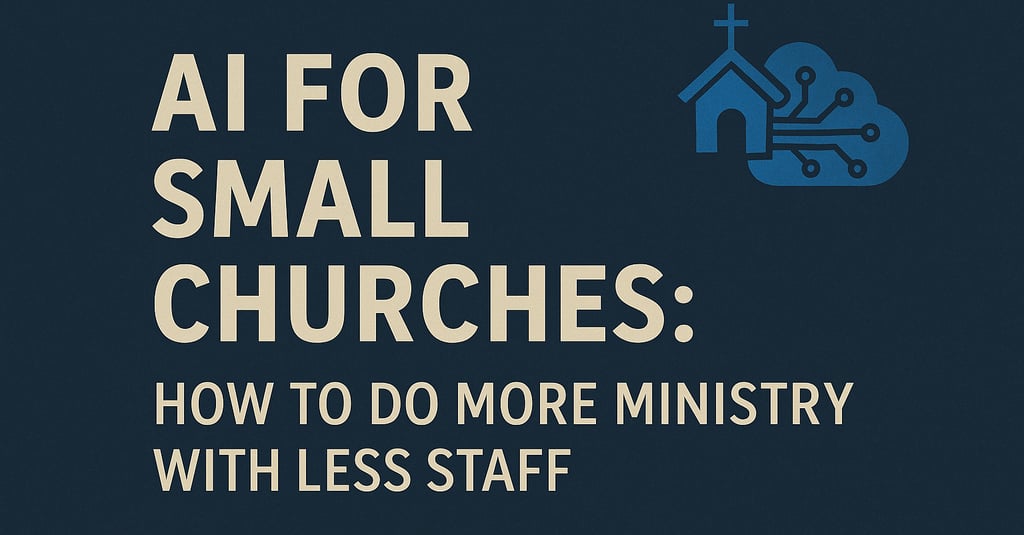AI for Small Churches: How to Do More Ministry with Less Staff
Learn how small churches can use AI in the church to save time, manage tasks, and focus on ministry with limited staff and resources.


The Challenge of Small Church Ministry
If you’re in a small church, you know what it’s like to wear every hat. One moment you’re the preacher, the next you’re the social media manager, event coordinator, custodian, and sometimes even the tech team.
The heart of your ministry is people — but the endless admin tasks often pull you away from the relationships and discipleship work you feel called to. And unlike larger congregations, you don’t have the luxury of a full staff to spread the workload.
That’s where AI in the church can make a meaningful difference.
1. Automate Routine Communications
Small churches thrive on relationships, but much of the communication you send is repetitive. Weekly announcements, reminder emails, or even thank-you notes can consume hours.
AI can:
Draft emails and bulletins in minutes
Write volunteer reminders or event updates
Create multiple social media posts from one piece of content
Instead of spending your energy on formatting, you can focus on personal follow-ups that really matter.
2. Simplify Sermon Prep
Sermon preparation is sacred work, but research and brainstorming can take up a disproportionate amount of time. With AI, you can:
Generate outlines and Scripture cross-references
Brainstorm relevant illustrations or applications
Create small group discussion questions based on your text
AI won’t do the preaching for you — but it can speed up the process so you have more space for prayer, reflection, and pastoral care.
3. Organize Ministry Tasks
Many pastors in smaller congregations are also administrators by default. AI can step in to:
Draft meeting agendas and follow-up notes
Suggest event checklists and timelines
Summarize long documents into key points
This keeps you organized without adding more hours to your week.
4. Spark Creativity in Outreach
Community engagement often gets sidelined because staff are stretched thin. AI tools can:
Brainstorm outreach ideas tailored to your context
Create quick graphics for flyers and social media
Suggest sermon series themes that connect with cultural moments
By reducing the time spent “getting started,” you gain momentum for creative ministry.
A Quick Aside: Wesley AI
Some AI tools are designed specifically for churches. For example, Wesley AI can live on a church’s website to answer visitor questions about service times, ministries, or theology — all without pulling staff away from ministry. It’s not about replacing personal touch, but about saving small staffs from answering the same questions over and over again.
AI and the Wesleyan Heritage
The Methodist movement has always embraced practical tools to spread the Gospel. From field preaching to printed hymnals, John Wesley believed in using every resource available to reach more people.
He reminded us, “Do all the good you can, by all the means you can.” Today, AI is simply another “means” — a tool that helps pastors maximize their time for people and mission.
Where to Start with AI in a Small Church
Start Small – Pick one task you repeat every week (like drafting the bulletin) and test AI for that.
Batch Content – Use AI to generate a month of social posts in one sitting.
Support Your Sermon Prep – Try it for outlines or illustrations, while keeping the message rooted in prayer and Scripture.
Consider a Website Assistant – Tools like Wesley AI can quietly answer visitor questions so you can stay focused on relationships.
Final Encouragement
If you’re serving in a small church, your calling is precious and your time is limited. AI won’t preach the Gospel, pray with a grieving family, or lead worship on Sunday — that’s your sacred work. But it can carry some of the administrative weight that often steals your time and energy.
AI in the church isn’t about replacing ministry. It’s about releasing ministry. It’s about giving pastors and small staffs the freedom to focus on people, discipleship, and the mission God has given you.

